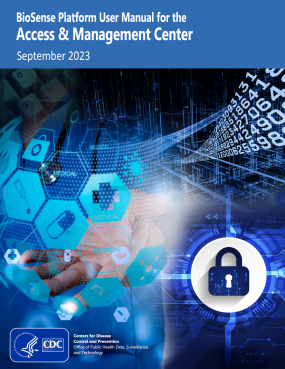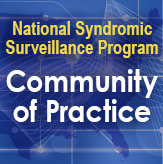Technical Updates
Updated October 13, 2023


Patching Schedule
- September 19: NSSP vendor patches (Testing and Development) 12:00–8:00 AM ET (Completed)
- September 21: NSSP vendor patches (Onboarding and Production) 12:00–8:00 AM ET (Completed)
- October 17: NSSP vendor patches (Testing and Development) 12:00–8:00 AM ET
- October 19: NSSP vendor patches (Onboarding and Production) 12:00–8:00 AM ET
NSSP Has a New Home
The National Syndromic Surveillance Program (NSSP) is now part of CDC’s new Office of Public Health Data, Surveillance, and Technology (OPHDST). OPHDST is CDC’s first office dedicated to leading, coordinating, and implementing a comprehensive public health data strategy designed to improve the availability and use of public health data to inform decision-making and action. Further, OPHDST serves as a platform for better partnerships and collaboration around public health data and surveillance, including data modernization.
Join CDC’s New Engagement Panel for Public Health Data
CDC’s new Office for Public Health Data, Surveillance, and Technology is kicking off the Engagement Panel for Public Health Data to incorporate the perspectives of public health partners into planning for Data Modernization and the Public Health Data Strategy.
The Engagement Panel will serve as a catalog of public health professionals who can be called upon to provide input on a technology product, a data policy, or modernization strategy. Engagements may include participation in
- focus groups to identify needs and opportunities,
- expert panels for in-depth discussion on specific topics or potential strategies,
- pilots to test initial versions of tools or services, or
- surveys to support user research into challenges and priorities.
Participation from all levels of public health is needed. Add your name and encourage participation by others involved in data modernization and data strategy.
Sign up for the Engagement Panel for Public Health Data to get involved! Email dmibuildingblocks@cdc.gov, and register using the link you receive.
‘By the Numbers’ Stats Highlight Sustained Growth
A description of the National Syndromic Surveillance Program (NSSP) can be found on our website, fact sheet, and infographic. We’ve recently updated “By the Numbers” and look forward to further expansion of facilities across NSSP in 2023:

More than 6,500 health care facilities covering 50 states, the District of Columbia, and Guam contribute data to NSSP daily.

Within 24 hours of a patient’s visit, data are available in NSSP for analysis.

78% of U.S. emergency departments send data to NSSP, often within 24 hours.

More than 8 million electronic health messages are received by NSSP every day.
NSSP Releases Software Update
On September 21, 2023, NSSP released software update 2.10 to the Access & Management Center (AMC), Data Quality Analytics and Visualization (DQAV), and New Data Source Development (NDSD). We thank members of the NSSP Community of Practice who voluntarily conducted user accessibility testing (UAT). Your feedback benefits users and helps us maintain high-quality products.
Internal and External UAT
- Manage Users tab: Added capability to capture User Type
- Data Access tab:
-
- Added framework for eventual addition of a new data source: National Notifiable Diseases Surveillance System (NNDSS)
- Implemented pagination for Data Table
- Added “Emergency Response” access flag
- Reports tab:
-
- Added a filter to remove NSSP Rules
- Implemented pagination for Data Table
Internal UAT Only
- Admin tab: Added a PIV Usage Report to support Operations Team
- Manage Users tab: Added capability to disable login after a period of inactivity
- MFT tab:
-
- Added Office of the National Coordinator for Health IT (ONC) Certified Health IT Product List (CHPL) identification
- Added capability to check for Duplicate Primary Facility Addresses
DQAV Updates
Internal and External UAT
- Added initial version of NSSP PRESS, which allows dynamic sharing of information between NSSP and sites
-
- Maintain a corpus of reports for NSSP community use
- Provide user interface (UI) for manual publication management
- Build UI on application programming interface (API) that can be leveraged to automate publication
- Refine and enhance DQDB filtering:
-
- Create extract, transform, and load pipeline for dashboard enhancement: Modify existing tables to aggregate completeness, validity, and timeliness metrics for C_Patient_Class by facility
- Added capability to apply filters to C_Patient_Class
NDSD Updates
Internal UAT Only
- Added Mortality Completeness Report
- Added .TRX (Transax) file format for use in Mortality Process Check

NSSP PRESS: Collaboration at its Best in a Shared Reporting Environment!
Unlike shared drives, code repositories, and other file hosting services, NSSP PRESS provides an association-focused, metadata-rich toolbox for contextualizing and connecting reports, authors, and audiences.
NSSP PRESS uses content tags, report categorization, user subscriptions, scheduled and serialized releases, and custom affinity groups. Public health agencies and constituents can build communities around centralized and interrelated content.
Initially, using your existing AMC credentials, you’ll be able to get dynamic, data-driven content NSSP publishes. Access NSSP PRESS from a menu item at the NSSP Dashboards URL.
Mortality Data
Onboarding of mortality data can be fast. To add the mortality data source for your site, please contact nssp@cdc.gov. Commonly asked questions about mortality data are posted on the NSSP website. An NSSP article describes the routing of mortality data. There’s also a slack channel: #Mortality-data.
Onboarding
NSSP’s onboarding team has been working to expand participation in California. The BioSense Platform is now receiving data from at least one facility in three new public health jurisdictions, including Long Beach, San Joaquin County, and San Diego County.
Questions about onboarding or data quality? Every other month the onboarding team hosts the BioSense Platform Data Validation Call to focus on what’s important to you. To join the next call, please email the NSSP mailbox (nssp@cdc.gov) or create an NSSP Service Desk ticket.
Publication Updates
- An Mortality and Morbidity Weekly Report (MMWR) describes Wisconsin public health officials use of wastewater surveillance and ED data to detect Influenza A and Respiratory Syncytial Virus, including the positive correlation they observed. By incorporating surveillance of wastewater with established systems such as NSSP, local preparedness and response to seasonal respiratory outbreaks might be improved. See “Wastewater Surveillance Data as a Complement to Emergency Department Visit Data for Tracking Incidence of Influenza A and Respiratory Syncytial Virus—Wisconsin, August 2022–March 2023.”

BioSense Platform
Data Validation Call:
October 4, 2023, 3:00–4:00 PM ET
To receive an invite, select “Onboarding Communications” in your AMC User Profile, or email a request to nssp@cdc.gov.
- A recently released MMWR gives insight into the emotional health and well-being of children and adolescents in relation to the academic year. NSSP data are used to describe weekly number, percentage, and proportion of emergency department visits for depressive disorders, suicidal ideation/self-harm, and trauma/stress among children aged 10–17 years. These disorders increase in the fall and start of the typical academic school year and remain elevated compared to summer. Systemic changes that prioritize protective factors and incorporate preparedness for increases in mental and behavioral health conditions during back-to-school planning may help improve child and adolescent mental health. See “Seasonal Trends in Emergency Department Visits for Mental and Behavioral Health Conditions Among Children and Adolescents Aged 5–17 Years—United States, January 2018–June 2023.”
- An MMWR, “Outbreak of Locally Acquired Mosquito-Transmitted (Autochthonous) Malaria—Florida and Texas, May–July 2023” describes eight cases of autochthonous malaria reported to CDC by state health departments in Florida and Texas. The risk for autochthonous malaria in the United States is low. But prompt diagnosis, treatment, and reporting of cases will improve outcomes. This is a good example of states using robust surveillance to prevent, detect, and respond to a public health threat.
- The Journal of Infectious Diseases published “Who Gets Sick From COVID-19? Sociodemographic Correlates of Severe Adult Health Outcomes During Alpha- and Delta-Variant Predominant Periods: September 2020–November 2021.” The article points out meaningful disparities in COVID-19 morbidity and mortality that are associated with sociodemography and geography. Awareness of and responding to these disparities could have helped to prevent the loss of lives.

An update to the BioSense Platform User Manual for the Access & Management Center has been posted under Technical Publications and Standards in the NSSP Technical Resource Center. This update reflects enhancements and changes to the user interface and functionality between release 1.6.3 and release 1.8.0. The NSSP is currently updating the manual to reflect the 2.10 update.
- An update to the NSSP Data Dictionary is posted under Technical Publications and Standards in the NSSP Technical Resource Center. The processing rationale to ArchiveProcessed had been updated, affecting C_Visit_Date and C_Biosense_ID. Also, the HL7 processing description is new for C_Unique_Patient_ID and C_Uniue_Patient_ID_Source.
